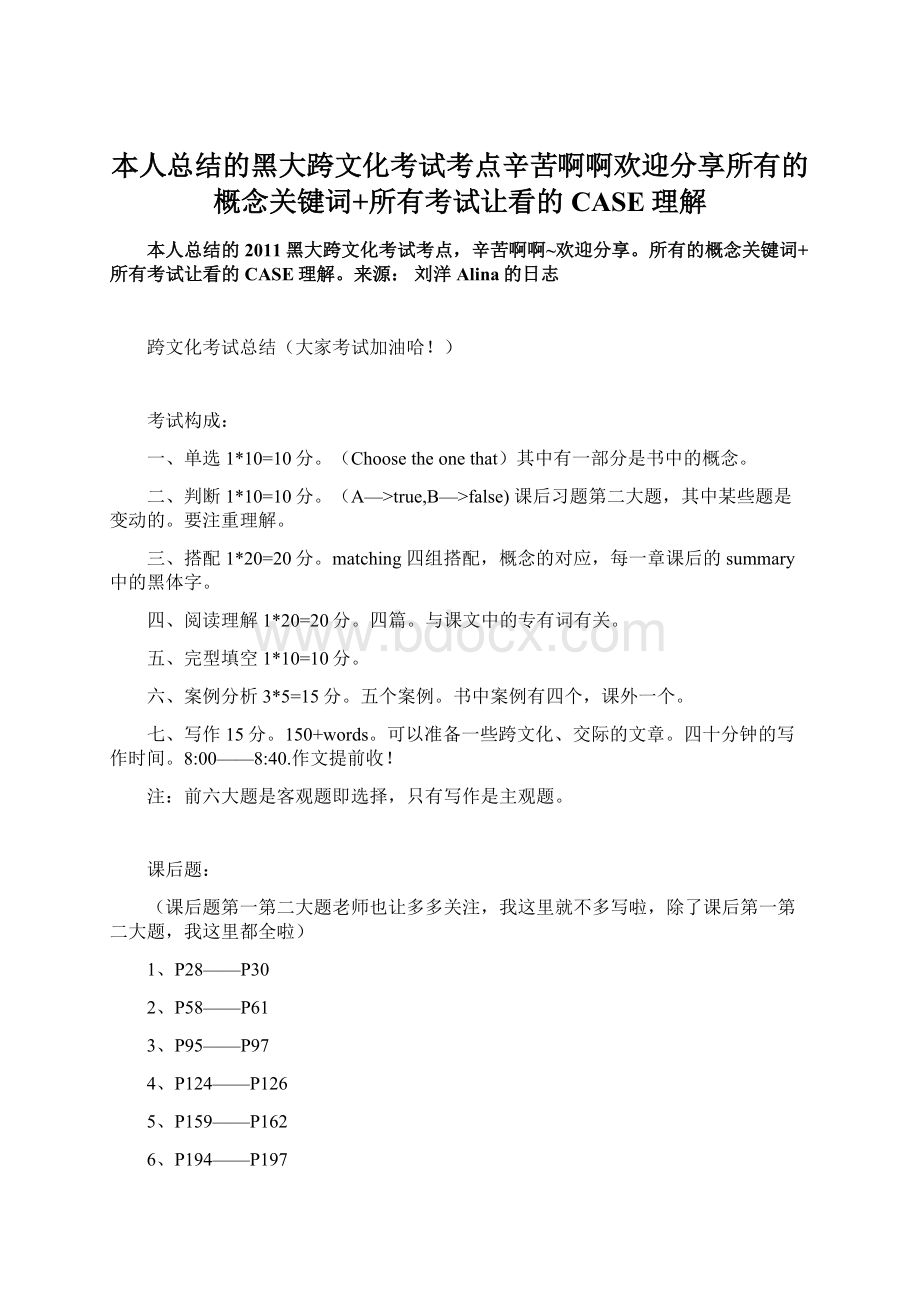本人总结的黑大跨文化考试考点辛苦啊啊欢迎分享所有的概念关键词+所有考试让看的CASE理解.docx
《本人总结的黑大跨文化考试考点辛苦啊啊欢迎分享所有的概念关键词+所有考试让看的CASE理解.docx》由会员分享,可在线阅读,更多相关《本人总结的黑大跨文化考试考点辛苦啊啊欢迎分享所有的概念关键词+所有考试让看的CASE理解.docx(12页珍藏版)》请在冰豆网上搜索。

本人总结的黑大跨文化考试考点辛苦啊啊欢迎分享所有的概念关键词+所有考试让看的CASE理解
本人总结的2011黑大跨文化考试考点,辛苦啊啊~欢迎分享。
所有的概念关键词+所有考试让看的CASE理解。
来源:
刘洋Alina的日志
跨文化考试总结(大家考试加油哈!
)
考试构成:
一、单选 1*10=10分。
(Choose the one that)其中有一部分是书中的概念。
二、判断 1*10=10分。
(A—>true,B—>false) 课后习题第二大题,其中某些题是变动的。
要注重理解。
三、搭配 1*20=20分。
matching 四组搭配,概念的对应,每一章课后的summary中的黑体字。
四、阅读理解 1*20=20分。
四篇。
与课文中的专有词有关。
五、完型填空 1*10=10分。
六、案例分析 3*5=15分。
五个案例。
书中案例有四个,课外一个。
七、写作 15分。
150+words。
可以准备一些跨文化、交际的文章。
四十分钟的写作时间。
8:
00——8:
40.作文提前收!
注:
前六大题是客观题即选择,只有写作是主观题。
课后题:
(课后题第一第二大题老师也让多多关注,我这里就不多写啦,除了课后第一第二大题,我这里都全啦)
1、P28——P30
2、P58——P61
3、P95——P97
4、P124——P126
5、P159——P162
6、P194——P197
7、P237——P240
8、P270——P272
9、P304——P306
所有概念关键词+考试范围内的CASE:
Chapter 1 Culture
Keywords
(1) Culture (from intellectual perspective):
Culture is “the arts and other manifestations of human intellectual achievement regarded collectively”(从知性角度定义文化:
作为整体的人类智力成就的艺术和其他表现。
)
(2) Culture (from anthropologic perspective):
Culture consists of patterns, explicit and implicit, of and for behavior acquired and transmitted by symbols, constituting the distinctive achievement of human groups, including their embodiments in artifacts; the essential core of culture consists of traditional ideas and especially their attached values”.(从人类学角度定义文化:
文化由清晰和模糊的行为模式构成,这些模式通过符号获得并传播,这些符号由人类群体的特别成就构成,包括具体的人工制品。
文化的基本核心由传统思想和与其相关的价值观构成。
)
(3) Culture ( from psychological perspective):
culture is the collective programming of he mind which distinguishes the members of one category of people from another。
(从心理学角度定义文化:
文化是使一个人类群体成员区别于其他人类群体的思维的总体规划。
)
(4) Culture (from socialogical perspective):
Culture is defined as a pattern of learned, group-related perception—including both verbal and nonverbal language, attitudes, values, belief system, disbelief systems, and behavior. (从社会学角度定义文化:
文化是一种可习得的、基于群体的认知模式——包括言语与非言语符号、态度、价值观、信仰和非信仰系统以及行为。
)
(5) Culture ( from intercultural communication perspective):
is the deposit of knowledge, experience, belief, values, actions, attitudes, hierarchies, religions, notions of time, roles, spatial relations, concepts of the universe, and artifacts acquired by a group of people in the course of generations through individual and group striving. (从跨文化交际学角度定义文化:
文化是个人和群体在种族发展过程中所获得的知识、经验、信仰、价值观、行为、态度、阶级、宗教、时间观、角色、空间观、宇宙观和艺术品的集合。
)
(6) Culture Identity:
refers to one’s sense of belonging to a particular culture or ethnic group.(文化身份:
认为自己归属于某一文化或民族群体的感觉。
)
(7) Subculture:
refers to a culture that exists within dominant culture, and is often based on economic or social class, ethnicity, race, or geographic region. (亚文化:
指存在于主流文化中的文化,其划分通常基于经济地位、社会阶层、民族、种族或地理区域。
)
Subcultures exist within dominant culture ,and are often based on economic or social class,ethnicity,race,or geographic region.
(8) Co-culture:
refers to groups or social communities exhibiting communication characteristics, perceptions, values, beliefs, and practices that are significantly different enough to distinguish them from the other groups, communities, and the dominant culture. (共文化:
指具有独特的交际特征、感知特点、价值观、信仰和行为,区别于其他群体、社团以及主流文化的群体或社团。
)
(9) Subgroup:
usually does not involve the same large number of people and is not necessarily thought of as accumulating values and patterns of behavior over generations in the same way as cultures do. (亚群体:
相对于亚文化和共文化群体,亚群体通常规模不大,也不一定有文化群体世代相传积累的价值观念和行为模式。
)
Case 2:
White Dress Case analysis:
The Indian women might think the wedding ceremony is a funeral if they see the western bride in white gown. The case reflects the similes and metaphors in the text. Culture is like an iceberg:
we can identify the color of the dress worn by women in different cultures, but we do not know the values underneath. Culture is like the water a fish swims in:
people wear dress of different colors for different context but they usually take it for granted and never ask why.
♣(6) Culture Identity:
refers to one’s sense of belonging to a particular culture or ethnic group.(文化身份:
认为自己归属于某一文化或民族群体的感觉。
)
Case 4:
Coconut-skating(用椰油保养地板的方法) Case analysis:
The case reflects the characteristics of culture. We can tell from the case that culture is pervasive and it’s learned. People may invent different ways for things even as simple as the issue of floor moping. The Philippine woman must have learned this way of mopping from her own culture.
Chapter 2 Communication and Intercultural Communication
Keywords
(1) Sender/Source:
A sender/source is the person who transmits a message.(信息发出者/信息源:
信息发出者/信息源指传递信息的人。
)
(2) Message:
A message is any signal that triggers the response of a receiver.(信息:
信息指引起信息接受者反应的任何信号。
)
(3) Encoding:
It refers to the activity during which the sender must choose certain words or nonverbal methods to send an intentional message. (编码:
编码指信息发出者选择言语或用非言语的方式发出有目的的信息的行为。
)
(4) Channel/Medium:
It is the method used to deliver a message. (渠道/媒介:
渠道/媒介指发送信息的方法。
)
(5) Receiver:
A receiver is any person who notices and gives some meaning to a message. (信息接受者:
信息接受者指信息接收者是指注意到信息并且赋予信息某些含义的人。
)